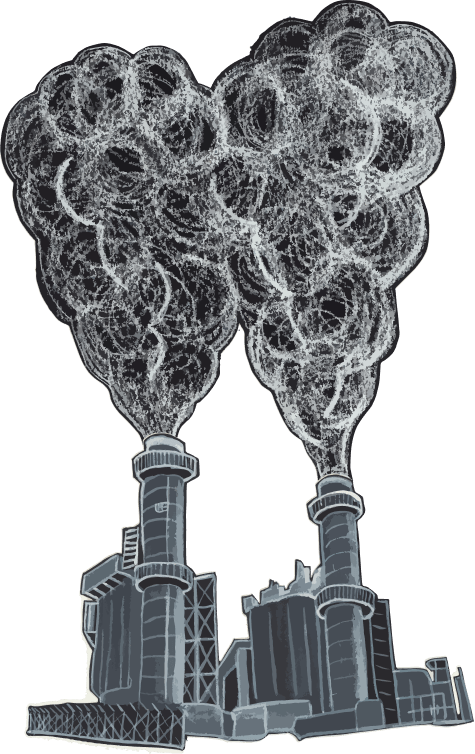New York
Back to mapTo get to zero by 2050, New York must cut emissions by 3.8% a year
Emissions in New York
Million metric tons of carbon dioxide (CO2) equivalent (MTCO2e
) emissions
Note: Grey area indicates missing data due to processing delays.
Source: WRI, Mar 2021
This is how we're going to do it
- Boilers and furnaces with heat pumps
- Gas stoves with electric induction stoves
- No-till farming to keep CO2 in the soil
- Capturing methane leaks from landfills
- Capturing CO2 to make emissions-free concrete
- Burning green hydrogen to make emissions-free steel
- Plugging methane leaks from gas pipelines
Decarbonize Our Buildings
30% of New York's climate pollution comes from buildings.
We burn fossil fuels to heat our air, water, and food.
To cut this pollution...
Let's electrify our heat!
We'll replace...
...in all of New York's 5.0 million buildings.
In fact, 19.4% of appliances in buildings in New York are already fossil fuel free!
That means we only need to electrify the remaining 4.0 million dirty buildings in New York. That's around 152,000 per year.
Source: Microsoft, Mar 2021; NREL, Dec 2021Electrifying all buildings cuts 30% of the pollution.
Decarbonize Our Transport
38% of New York's pollution comes from cars, trucks, trains, and planes.
But mostly from cars.
To cut this pollution,
your next car must be electric.
Or consider going car-free with public transit, bikes/e-bikes, car share, or other alternatives!
There are 4.2 million vehicles in New York and 33,000 are already electric (0.8% of the total).
We need to electrify (or replace) the remaining 4.2 million gas-powered vehicles. That's around 160,000 a year.
Source: DOT, Feb 2021Electrifying all transportation cuts 38% of the pollution.
Decarbonize Our Power
12% of New York's pollution comes from burning coal, gas, and oil to make power.

That's because of how power is generated in New York today.
Power Generation in the State of New York (2020)
But there's already 59% carbon-free electricity generation in New York!
To clean up the emissions from the polluting power plants we need to replace all fossil fuel power plants with solar and wind farms.

...and find good jobs for those workers.
Current Fossil Fuel Power Plants in New York
2 coal plants
655 MW
323 MW
94 gas plants
2,957 MW
1,992 MW
1,564 MW
1,345 MW
1,293 MW
1,245 MW
1,222 MW
1,086 MW
896 MW
770 MW
716 MW
687 MW
666 MW
654 MW
590 MW
537 MW
528 MW
446 MW
352 MW
349 MW
322 MW
286 MW
240 MW
221 MW
210 MW
171 MW
164 MW
162 MW
147 MW
123 MW
122 MW
120 MW
108 MW
104 MW
103 MW
100 MW
98 MW
96 MW
94 MW
94 MW
94 MW
94 MW
91 MW
88 MW
82 MW
72 MW
67 MW
67 MW
66 MW
65 MW
63 MW
61 MW
60 MW
57 MW
57 MW
55 MW
50 MW
50 MW
47 MW
47 MW
47 MW
47 MW
47 MW
42 MW
40 MW
34 MW
27 MW
25 MW
23 MW
23 MW
22 MW
19 MW
18 MW
17 MW
13 MW
7 MW
6 MW
6 MW
6 MW
5 MW
5 MW
4 MW
4 MW
4 MW
4 MW
2 MW
2 MW
2 MW
2 MW
2 MW
1 MW
1 MW
1 MW
1 MW
55 oil plants
1,896 MW
1,242 MW
733 MW
567 MW
338 MW
239 MW
109 MW
100 MW
72 MW
61 MW
54 MW
52 MW
42 MW
37 MW
27 MW
22 MW
19 MW
16 MW
15 MW
14 MW
12 MW
12 MW
12 MW
10 MW
10 MW
9 MW
8 MW
8 MW
8 MW
7 MW
7 MW
6 MW
6 MW
5 MW
5 MW
5 MW
4 MW
4 MW
3 MW
3 MW
3 MW
3 MW
3 MW
2 MW
2 MW
2 MW
2 MW
2 MW
2 MW
1 MW
1 MW
1 MW
1 MW
1 MW
1 MW
But wait!
It's not enough to replace our power plants with wind and solar farms.
To power our electric cars and buildings, we need two times the electricity we have today.
In all, we'll need to build 16,000 megawatt (MW) of wind power and 13,000 MW of solar power.
Since the average wind turbine provides 2.75 MW of peak capacity, New York would need to install about 6,000 turbines.
Since New York already has 501 MW of wind and 448 MW of solar, that's 15,000 MW of wind power we need to build and 13,000 MW of solar power. That's around 591 MW of wind power and 484 MW of solar power a year.
Source: EIA, Apr 2022Decarbonizing all dirty power cuts 12% of the pollution.
And gives us zero-emissions power we need to eliminate pollution from buildings and cars!
Other Emissions
The last 21% of New York's climate pollution comes from other sources...
This includes farming, landfills, industry, and leaks from gas pipelines.
There's no one solution to solve these problems, but there are lots of great ideas:
That doesn't mean there's no solution, it just means that clean electrification doesn't help with these problems, and you could fill a whole book with covering all of them. We need to encourage our politicians to invest in researching new solutions and implementing existing solutions to these problems!
Ready to do your part?
Learn how to electrify your own machines and pass local policy to electrify the rest
Take Action